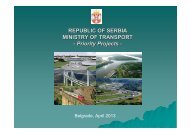Innovation Canada: A Call to Action
Innovation Canada: A Call to Action
Innovation Canada: A Call to Action
You also want an ePaper? Increase the reach of your titles
YUMPU automatically turns print PDFs into web optimized ePapers that Google loves.
Executive Summaryprovide a national “concierge” service andassociated website <strong>to</strong> help firms find andaccess the support <strong>to</strong>ols they needwork with partners <strong>to</strong> develop a federalbusiness innovation talent strategy.Moreover, the IRIC could assume the followingresponsibilities: in partnership with the federalgranting agencies, joint oversight of appropriatebusiness-facing programs administered by thoseagencies; technical assessment of the innovationelement of project proposals submitted <strong>to</strong> theregional development agencies; and oversigh<strong>to</strong>f federal support for business-orientedcollaborative research institutes evolved fromthe current institutes of the National ResearchCouncil, as further discussed below.Scientific Research and ExperimentalDevelopment (SR&ED) Tax CreditIn line with feedback from stakeholders, we arerecommending that the SR&ED program shouldbe simplified. Specifically, for SMEs, the base forthe tax credit should be labour-related costs, andthe tax credit rate should be adjusted upward.The current base, which is wider than that usedby many other countries, includes non-labourcosts, such as materials and capital equipment,the calculation of which can be highly complex.This complexity results in excessive compliancecosts for claimants and dissipates a portion ofthe program’s benefit in fees for third-partyconsultants hired <strong>to</strong> prepare claims.<strong>Canada</strong>’s program mix is heavily weighted<strong>to</strong>ward the SR&ED program and, during ourconsultations, we heard many calls for increaseddirect expenditure support. As well, manyleading countries in innovation rely much lessthan <strong>Canada</strong> on indirect tax incentives asopposed <strong>to</strong> direct measures. That is why we arerecommending other improvements <strong>to</strong> theSR&ED program that will generate savingsfor the government. The savings should beredeployed <strong>to</strong> fund direct support measures forSMEs, as proposed in our otherrecommendations. Specifically, <strong>to</strong> ensure agreater focus on promoting the growth of firms,the portion of the credit (claimed by SMEs) thatis refundable — that is, paid regardless ofwhether the firm generates taxable income —should be reduced, such that part of the benefitwould depend on the company beingprofitable. Given the central importance of theSR&ED program <strong>to</strong> firms across the country, ourrecommended changes should be phased inover several years <strong>to</strong> allow time for adjustment.Risk CapitalInnovative, growing firms require risk capital, yet<strong>to</strong>o many innovation-based Canadian firms thathave the potential for high growth are unable <strong>to</strong>access the funding needed <strong>to</strong> realize theirpotential. The government can play animportant role by facilitating access by suchfirms <strong>to</strong> an increased supply of risk capital atboth the start-up and later stages of theirgrowth. We therefore recommend measures <strong>to</strong>establish risk capital funds that target theseareas. The federal government’s contribution<strong>to</strong> the funds would be delivered through theBusiness Development Bank of <strong>Canada</strong> (BDC),with incentives and governance designed <strong>to</strong>ensure strong private sec<strong>to</strong>r participationand leadership.Collaborative R&D Institutes<strong>Canada</strong> needs a fundamentally new approach<strong>to</strong> building public–private researchcollaborations in areas of strategic importanceand opportunity for the economy. Accordingly,we recommend that the business-orientedinstitutes of the National Research Council(NRC) should become independent collaborativeresearch organizations, intended <strong>to</strong> be focalpoints for sec<strong>to</strong>ral research and innovationstrategies with the private sec<strong>to</strong>r. Those NRCinstitutes that perform primarily fundamentalresearch would become affiliates of universities,E-3
















